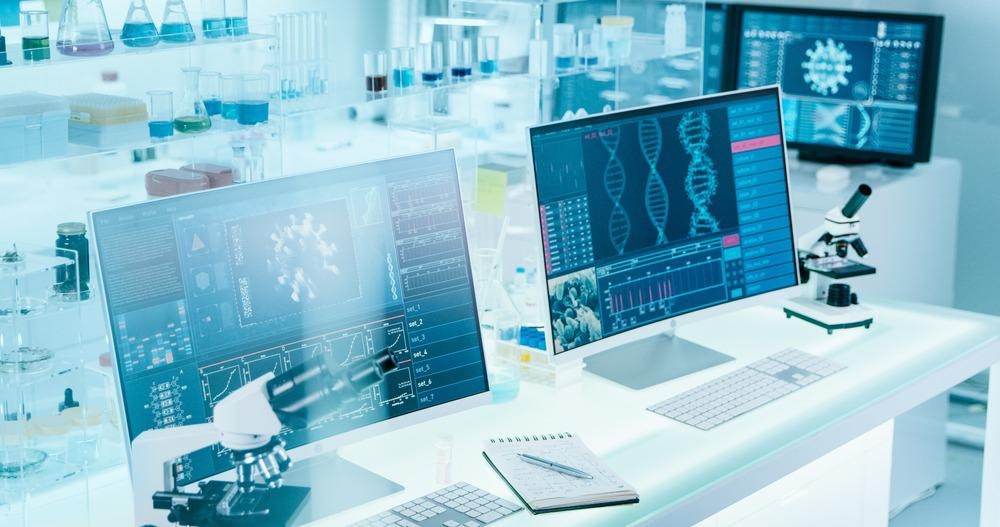Novel designs of biosensors have allowed for the real-time analysis of hydrogel-based cultures within the field of tissue engineering and drug development. This research has been covered in a review published in the journal, Sensors.

Study: Biosensors to Monitor Cell Activity in 3D Hydrogel-Based Tissue Models. Image Credit: Marcin Janiec/Shutterstock.com
3D Hydrogel-based Tissue Models
3D culture models can be seen as more useful than their 2D counterparts with their ability to provide an enhanced insight into the physiology of the human body.
The use of natural, synthetic and hybrid material-based hydrogels have been used as scaffolds in 3D culture and are beneficial, with their ability to imitate native extracellular matrix (ECM) as well as their cell encapsulation capability.
The use of hydrogels, which are hydrophilic polymer chains within water-based 3D substrates allows cells to be entrapped in vitro and illustrate comparisons to tissue complexities found in the body. This can also enable molecules to diffuse through the porous network, with key mechanical and biochemical features of human tissue, as a result of high-water content, softness, and reticulated structure.
This structural resemblance can also allow for effective oxygen, nutrients and signaling molecules to be transported, as well as enabling cell migration and arrangement.
Incorporating Biosensors
Biosensors can be described as self-contained analytical device that allows for the detection of an analyte through the combination of both a biological and physicochemical component.
These analytical devices consist of a receptor of a biological sample, a transducer as well as a system to detect results and convert them into a measurable signal.
Biosensors are able to measure very small signals from biological samples – this provides insightful analysis of analytes in a non-invasive way. This could include measurements of molecules involved in metabolisms such as pH, oxygen and glucose.
The use of this sophisticated non-invasive approach to monitoring cell behavior and activity can be seen as more useful than conventional methods, such as with optical/confocal microscopes, which can be used to assess cell morphology, viability and proliferation, but is limited when providing effective visual projections of 3D structures; additionally, when visualization is enabled, other drawbacks such as time-consuming quantitative analysis can limit this approach.
Applications
Biosensors can be integrated into advanced in vitro models and can be used for different applications such as monitoring metabolism within drug efficacy studies, as well as the efficacy of anticancer drugs for cancer therapeutics.
These applications would be significant for advancing biomedical research as they would allow for more information to be gained from the 3D hydrogel-based tissue model about cell activity in an environment similar to that in native tissue.
Additionally, with the demand for organs for use in transplantation such as for the liver, kidneys and pancreas, gaining more information about tissue models allows for researchers to explore 3D organ culture.
Other applications such as anti-cancer drug screening and the drawbacks of using animal models have also led researchers to look towards 3D organ culture and the use of 3D hydrogel-based tissue models that is provides a better insight into in vivo effects, in comparison to 2D culture.
This allows researchers to gain a higher comprehension about how the drug can affect cell activity, and the use of biosensors is critical for monitoring this effect.
Advancements in the development of 3D hydrogel-based tissue models and biosensor technology have significantly increased over recent years; however, their integration into standardized cell culture platforms is still in its infant stage.
Translation of Biosensor Technology
The continuous development of biosensor technology enables its use for measuring cell activity to also advance in the aim of providing a comprehensive analysis of analytes within 3D models.
With pH being an emerging hallmark for cancer, such as detecting an acidic pH of 6.2-6.9, the use of biosensors can prove critical for understanding pathogenesis and furthering the field of therapeutics.
The biosensor design for this type of measurement would have to ensure the sensor itself does not cause a reaction from cells, as well as being sensitive to a wide range of pH responses along with 3D grafts and being non-invasive.
These components would ensure biosensors are able to appropriate function within a tissue model.
The field of biosensors for this application in 3D hydrogel-based tissue models can encompass a variety of detection methods, from pH biosensors, to electrochemical, ion-sensitive field-effect transistors (ISFET), optical and light-addressable potentiometric (LAP).
These variations of biosensors aim to provide innovative solutions to adapt to the pH sensing approaches within hydrogel-based systems, and this can aid with advancing biosensor technology and the integration into standardized cell culture, which has so far been limited.
Additionally, the use of these biosensors can also function to monitor other cellular activity components including glucose monitoring for research into diabetes.
The versatility of biosensors can be useful for monitoring various analytes and provide data for researchers to build upon with further understanding from 3D hydrogel-based tissue models that imitate the effects of potential treatments on cellular activity. This aims to advance the quality of therapeutics and care available for patients, with further comprehension allowing innovative medical solutions.
Reference
Fedi, A., Vitale, C., Giannoni, P., Caluori, G. and Marrella, A., (2022) Biosensors to Monitor Cell Activity in 3D Hydrogel-Based Tissue Models. Sensors, 22(4), p.1517. Available at: https://www.mdpi.com/1424-8220/22/4/1517/htm
Further Reading
Chaudhary, S. and Chakraborty, E., (2022) Hydrogel based tissue engineering and its future applications in personalized disease modeling and regenerative therapy. Beni-Suef University Journal of Basic and Applied Sciences, 11(1). Available at: https://bjbas.springeropen.com/articles/10.1186/s43088-021-00172-1
Disclaimer: The views expressed here are those of the author expressed in their private capacity and do not necessarily represent the views of AZoM.com Limited T/A AZoNetwork the owner and operator of this website. This disclaimer forms part of the Terms and conditions of use of this website.